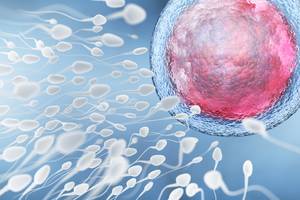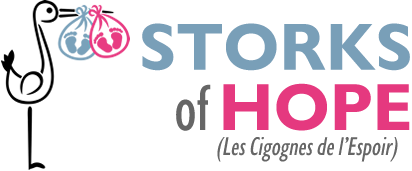Artificial insemination

This is the oldest and simplest assisted reproduction technique used in the simplest cases of male or female infertility. This method has been practised for 200 years, but at that time the results were mediocre and until the 1950s the success rate was no more than 3.5%.
Today, pregnancy rates have improved when artificial insemination is used as a method of procreation, but still remain low at 15%. This method of procreation results in a rate of 2.25% of twins and 0.45% of triplets due to the ovarian stimulation performed on the woman.
Medical reasons for insemination
The aim of artificial insemination is to deposit sperm directly into the uterus (sometimes only at the cervix) in order to bring sperm and egg into direct contact.
This method of medically assisted procreation is used mainly in the following cases of infertility:
For women:
- abnormality of the cervix or cervical mucus which prevents the passage of spermatozoa (poor quality or insufficient mucus),
- mild endometriosis.
For men:
- problems with erection or ejaculation (anatomical anomalies, neurological disorders, retrograde ejaculation, neurological or psychological impotence),
- poor sperm quality (laboratory sperm preparation techniques have improved sperm quality, and injecting the sperm directly into the uterus makes it easier for the sperm to travel up the fallopian tubes, speeding up fertilisation),
- no spermatozoa or a hereditary disease (in this case, insemination with a donor, known as DAI, will be carried out).
It is also used in cases of mixed male and female infertility.
Insemination procedure
1st stage: a full clinical assessment to determine the causes of infertility
For the man, this assessment includes:
- a spermogram to analyse sperm quality and the absence of viral infection,
- serology (to assess immunity to various diseases),
- clinical examination.
For the woman, this assessment includes:
- hysterosalpingography to check the state of the uterus and ensure that the fallopian tubes are not blocked,
- hormonal dosages to check hormonal conditions,
- serology,
- clinical examination.
2nd stage: monitoring the onset of natural ovulation or ovulation stimulation
Insemination can be carried out during spontaneous ovulation when infertility is caused by an obstacle in the female genital tract or a cause linked to the quality of the male partner's sperm. In this case, the doctor will simply take blood samples to check for a peak in luteinising hormone (LH), proof that ovulation has taken place. He will also check follicular development using ultrasound scans.
In most cases, the doctor will stimulate ovulation with an ovulation-inducing treatment during the first half of the cycle, monitored by ultrasound and hormone levels, followed by an injection of Human Chorionic Gonadotropin (hCG) to trigger ovulation. The aim is to obtain 2 or 3 mature follicles.
Insemination will take place 36 hours after the Luteinizing Hormone (LH) peak or the hCG injection.
3rd stage: sperm collection
The sperm is collected by masturbation after a period of abstinence of 3 to 5 days (to obtain the best possible concentration) in a specialised laboratory approved by the Ministry of Health to collect sperm. The sperm collected will be analysed and then prepared to select the most mobile spermatozoa and eliminate the other cells. Once ready, the sperm is inserted into a syringe connected to a catheter for the actual insemination.
Both fresh and frozen sperm (from the male partner or a donor) can be used.
4th stage: insemination
The aim of insemination is to facilitate the meeting of egg and spermatozoa. In practical terms, the doctor deposits the spermatozoa inside the uterus using a fine catheter connected to a syringe containing the prepared spermatozoa, with the female in the gynaecological position. The most mobile spermatozoa travel up the fallopian tubes to meet the egg. As fertilisation takes place inside the woman's body, this is known as ‘in vivo’ fertilisation. In some cases, the spermatozoa are deposited in the cervix, in what is known as ‘intra cervical’ fertilisation, which is used less frequently because it is less effective.
Insemination is completely painless.
After insemination, the woman lies down for about 30 minutes and then resumes her normal life.
If the woman does not menstruate within 18 days, a pregnancy test is carried out.
Donor insemination
In certain cases of male infertility, when the male partner cannot produce sperm (azoospermia) or in the case of a hereditary disease, it is possible to call on a sperm donor. This is known as ‘DAI’ (donor insemination).
This is a regulated procedure:
- sperm is generally supplied by Fertility Centres or Clinics,
- the donor is generally aged between 18 and 45 – this depends on the laws of the country,
- it is not always necessary to have had a child – this depends on the laws of the country,
- donation is anonymous – this depends on the laws of the country,
- donation is free, expenses might be reimbursed depending on the country,
- the donor must have the agreement of his or her spouse or partner – this depends on the laws of the country,
- the number of children per donor might be limited and the number varies depending on the country.
5th stage: results
The success rate is 10-15% per treatment cycle. This is due to ovarian stimulation, 15% of pregnancies result in twins and 3% in triplets.
In the event of failure, it is advisable to take a rest cycle between each insemination attempt, and the success rate is very low if more than 6 attempts are made.

